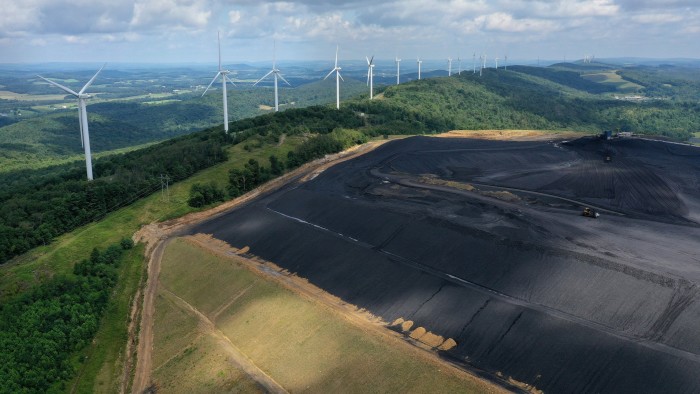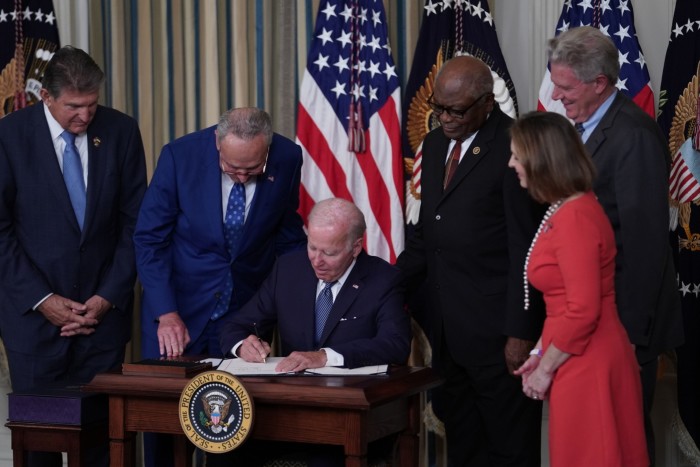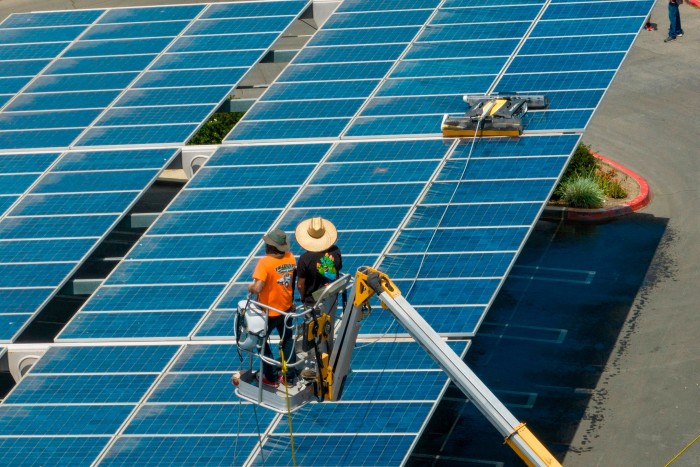US faces challenges in bid to hit Paris goals

Roula Khalaf, Editor of the FT, selects her favourite stories in this weekly newsletter.
Joe Biden’s flagship economic legislation represents the largest single US investment in climate and clean energy programmes in the country’s history. But even more work is needed if the world’s leading economy is to meet its Paris climate goals, analysts say.
The US has committed to reducing its greenhouse gas emissions by 50 to 52 per cent below 2005 levels by 2030. When all the effects of the recent legislation, called the Inflation Reduction Act, are factored in, research from Rhodium Group suggests that the country is on track for a 31 to 44 per cent reduction.
So, to make up the shortfall, Rhodium reckons the US will need more federal regulation to limit power plants’ emissions and decrease those from cars and trucks. Also required will be more climate-friendly infrastructure and transport policies from states, and the faster retirement of coal- and gas-fired power stations.
In modelling how the US could halve its emissions by 2030, the researchers assumed that all power companies that promised to transition to becoming 100 per cent clean moved their targets forward to 2035.
“We should not minimise the extent to which this [ambition] is a huge lift across not just the federal government, but across all state governments, to get to this,” says Ben King, an associate director at Rhodium’s energy and climate practice.
The Inflation Reduction Act seeks to enable this with some of the most significant legislation to mitigate climate change enacted in the US, committing $369bn to environmental and clean energy initiatives. It passed in August, though Congress may block further proposals by the Biden administration if the Republicans win a majority in either the Senate or House of Representatives in today’s midterm US elections.

Central to the programme are billions of dollars of tax credits designed to supercharge development of a US clean energy industry and speed the adoption of electric vehicles across the country.
About $30bn in grants and loans are available to utilities to help their transition to clean energy, while $6bn in grants and tax credits are available to help some of the worst polluters in industrial manufacturing — including chemical, steel and cement plants — to lower their emissions.
A further $27bn is aimed at supporting the rollout of nascent technologies that reduce emissions and $20bn for rural communities to invest in climate-friendly agricultural practices, forest restoration and land conservation.

Tax credits are also available to prospective buyers of electric cars and to poorer people who want to switch from oil or gas heating of their homes or install green technologies, such as heat pumps and solar panels.
Todd Tucker of the Roosevelt Institute, a think-tank, says the legislation represents a “big shift” in US thinking: “It marks a clear pivot away from decades of more neoliberal-oriented policy . . . we’re going to actually see a proper role for the government and for the public sector in directing the industrial future of the country.”
The longer-term hope, says Tucker, is that the incentives contained in the legislation will encourage the rapid growth of the green industry across the US, in turn making it a potent political force.
“What the IRA does is begin to level the playing field by giving green capital as much or closer to the power of the incumbent fossil fuel industry,” he says. “You actually want to redraw the lines of influence, so that policymakers are being responsive to the new green capital and green labour.”
Biden’s approach contrasts sharply with that of his predecessor, Donald Trump, who announced in 2017 that he would withdraw the US from the Paris accord, struck in 2015. The US left in 2020, then rejoined under Biden.
But the current administration has suffered setbacks to its ambitions to reach the Paris goal, including a recent ruling by the Supreme Court that curtailed the power of the US’s top environmental regulator.
In July, the court’s conservative majority struck down an obsolete Obama-era plan to shift power generation away from coal-fired plants and towards renewable sources across the American energy grid.
The justices, invoking a legal principle known as the “major questions” doctrine, said that they expected Congress to legislate more clearly for “how much coal-based generation” there should be across the US power grid.
More stories from this report
‘Loss and damage’ debate set to dominate the COP27 agenda
Australia takes steps to catch up on climate action
Amazon woes overshadow Brazil’s farming advances
UK’s COP26 chief ‘fully invested’ in continued climate champion role
Watchdogs call for rules to come clean on green finance claims
European crisis risks climate action reputation
India plots tricky path to growth and net zero
The ruling throws the regulatory power of the Environmental Protection Agency into doubt.
Meanwhile, Russia’s war in Ukraine has prompted a European energy crisis, drawn political attention to the increase in US petrol prices, and forced Biden both to cut federal fuel taxes and release millions of barrels of oil from strategic reserves.
Climate advocates have also criticised the Biden administration for backing the expansion of infrastructure for liquefied natural gas imports across Europe, and for meeting Japanese officials earlier this month to discuss US LNG exports to the country.
Jennifer Hensley, a director at climate advocacy group the Sierra Club, says the positions on LNG expansion and the release of strategic reserves are “unfortunate” and that building out LNG infrastructure in the US or Europe would “not address the [energy] crisis now”.
“Expanding LNG terminals — that is going to take a couple of years for that gas to actually hit the market,” says Hensley. “And, at that point, we have built infrastructure and we’re going to hear the industry saying ‘these are stranded assets, we can’t possibly retire them’. So, yes, from that perspective, that’s disappointing.”

Collin Rees, of environmental campaign group Oil Change International, says that while the IRA moved the US towards significantly reducing its emissions, the US is not doing enough to reduce emissions globally.
“It’s really a question of how are you setting both the US and the world up to get those final parts of emissions, and that’s where something like the LNG build-up becomes really concerning.”
Climate Capital

Where climate change meets business, markets and politics. Explore the FT’s coverage here.
Are you curious about the FT’s environmental sustainability commitments? Find out more about our science-based targets here
Comments